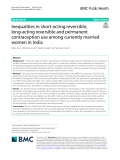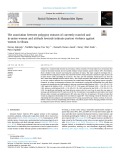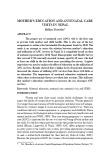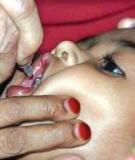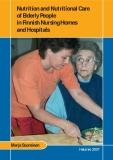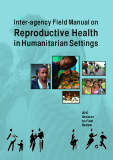
Currently married women
-
In India, the usage of modern contraception methods among women is relatively lower in comparison to other developed economies. Even within India, there is a state-wise variation in family planning use that leads to unintended pregnancies.
 13p
13p  viferrari
viferrari
 28-11-2022
28-11-2022
 6
6
 2
2
 Download
Download
-
The study revealed that women in polygynous relationships were more likely to support IPV. These findings extend the literature on the relationship between polygyny and endorsement of IPV among reproductive-age women in Ghana. It also contributes evidence towards strengthening interventions and policies geared towards changing attitudes of women in polygynous unions towards intimate partner violence.
 9p
9p  lazzaro
lazzaro
 30-12-2021
30-12-2021
 7
7
 0
0
 Download
Download
-
Marriage is an important personal and social affair. A qualitative research was conducted to study attitude of present generation towards marriage.Sample size was 51. There was the use of triangulation of data and methods. When the study was carried out first, the qualitative data were collected by in-depth interview and analyzed manually in the interpretive-thematic analysis framework. Data saturated after 16 persons of marriageable age, those between 18 and 35, were interviewed.Some were interviewed twice or thrice.
 18p
18p  nguathienthan1
nguathienthan1
 27-11-2019
27-11-2019
 22
22
 1
1
 Download
Download
-
Nepal has a fairly high adolescent fertility rate and low use of contraception. Lack of contraceptive use is a major contributor to the high rates of unintended pregnancies amongst youth. There is also lack of specific studies dealing with contraceptive behavior among young married women. This study examines the use and determinants of contraceptive methods over the time period of 15 years (2001-2016) among young women in Nepal. Trend and bi-vatiate analysis of this study is based on the Nepal Demographic and Health Survey (NDHS), 2001, 2006, 2011 and 2016 data.
 22p
22p  nguathienthan1
nguathienthan1
 24-11-2019
24-11-2019
 39
39
 2
2
 Download
Download
-
The proper use of antenatal care (ANC) visit is the first step to prevent both mother and child health. This is also one of the key components to achieve the Sustainable Development Goals by 2030. The study is an attempt to assess the relation between mother’s education and utilization of ANC services in Nepal. It is completely based on data of national representative 2016 Nepal Demographic and Health Survey that covered 2,746 currently married women, aged 15-49 years who had at least one child in the last three years preceding the survey.
 12p
12p  nguathienthan1
nguathienthan1
 24-11-2019
24-11-2019
 24
24
 1
1
 Download
Download
-
Reducing the number of unwanted pregnancies reduces the risk of maternal deaths. The contraceptive prevalence rate is only about 55 per cent leaving the rest of the women exposed to the risk of pregnancy, in many cases unwanted. Unmet need on contraception (limiting and spacing) is 21 per cent.33 About 16 per cent of girls in the age-group 15-19 have begun childbearing (either have had a live birth or pregnant with the first child).34 The poor status of health of child-bearing adolescents, coupled with physiological immaturity elevates the risk of maternal and perinatal deaths.
 38p
38p  nhamnhiqa
nhamnhiqa
 01-03-2013
01-03-2013
 43
43
 4
4
 Download
Download
-
The distribution of women and men age 15-49 by background characteristics is shown in Table 2. The distribution by age shows a decline in numbers of women and men with increasing age. About 41 percent of women and 46 percent of men are aged 15-24. The overwhelming majority of Rwandan women and men are Christians (Catholics, Protestants, or Adventists). Fifty percent of women are currently married or living with a man in a consensual union as are 48 percent of men. Because Rwandan men tend to marry later in life than women, 51 percent of men in the sample have...
 78p
78p  nhamnhiqa
nhamnhiqa
 01-03-2013
01-03-2013
 42
42
 2
2
 Download
Download
-
The sex distribution in SEC is reasonably close to that in the 1998 census and 2000 DHS. The 1999 Socioeconomic Survey is somewhat out of line with the other sources. Likewise, the age distribution of older persons in the SEC is quite similar to that in the other sources. The marital status distribution in the SES for men is also fairly similar to that found in the other three sources but not for women. The SEC sample has relatively fewer women who are currently married and relatively more who are widowed than indicated by the census and the...
 76p
76p  ut_hai_can
ut_hai_can
 26-12-2012
26-12-2012
 74
74
 12
12
 Download
Download
-
Adolescents, currently about 20 percent of the world’s population, have special reproductive health concerns and face risks related to early sexual experience, marriage and fertility. A rise in the age of marriage globally has contributed to declines in adolescent fertility. However, up to 50 percent of women in some countries still marry or enter a union by age 18, with this figure rising to 70 per- cent by age 20. The proportion of young women married or in union by age 20 is closely linked to adolescent fertility and exposure to reproductive health risks....
 222p
222p  thankinhphanliet
thankinhphanliet
 21-12-2012
21-12-2012
 61
61
 7
7
 Download
Download
-
In all regions, knowledge of any method of contraception is high among young women and nearly universal among young men. However, knowledge of multiple methods is lower among young women and men in sub-Saharan Africa than their counterparts in other regions. Current use of modern contraception among married youth is lowest in sub-Saharan Africa. Overall, although sexually active, unmarried young women are more likely to use modern contraceptive methods, they also have higher levels of unmet need for contraception compared to currently married young women.
 104p
104p  thankinhphanliet
thankinhphanliet
 21-12-2012
21-12-2012
 54
54
 4
4
 Download
Download
CHỦ ĐỀ BẠN MUỐN TÌM








